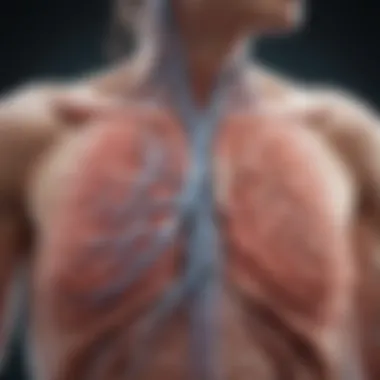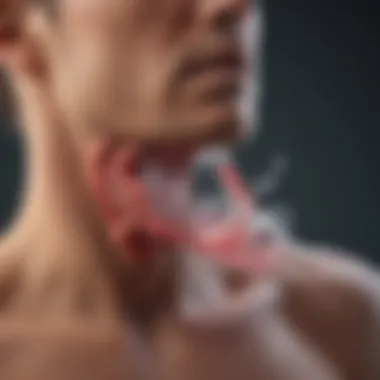Exploring the Nuances of COPD Cough


Intro
Chronic Obstructive Pulmonary Disease (COPD) is an umbrella term that encompasses various progressive lung conditions, predominantly chronic bronchitis and emphysema. Millions of individuals across the globe battle this ailment, and a persistent cough is often one of the most distressing symptoms they face. Understanding the intricacies of COPD-related cough is crucial, as it has significant implications for both diagnosis and management, shaping the patients' day-to-day lives.
An effective exploration of COPD cough is not solely about understanding the symptoms; we must grasp the underlying mechanisms and the unique characteristics that set this cough apart from those caused by other respiratory conditions. This nuanced examination will not only illuminate the physiological processes involved but will also provide insights into the psychosocial struggles associated with chronic cough.
By delving into the various facets of COPD cough, we explore the challenges faced by patients and caregivers alike. In doing so, we highlight the importance of comprehensive management strategies that can substantially improve the quality of life for those afflicted. Let's embark on a detailed journey to dissect the many layers that define COPD cough, examining its implications from multiple perspectives.
Prolusion to COPD
Chronic Obstructive Pulmonary Disease, commonly known as COPD, is not just a cough or a fleeting breath, it encapsulates a complex array of respiratory issues that can profoundly affect a person’s life. Understanding this condition is crucial, especially for those who are on the front lines of healthcare, care-giving, and even family members of those diagnosed. As COPD is one of the leading causes of morbidity and mortality globally, knowing its intricacies prepares us for more informed discussions and better management strategies.
Definition and Overview
COPD represents a spectrum of lung diseases that block airflow and make breathing increasingly difficult. Commonly, it includes emphysema and chronic bronchitis, both of which exacerbate respiratory ailments. The primary culprit for this condition is often long-term exposure to harmful substances, predominantly tobacco smoke, but not solely. Prolonged exposure to pollutants and chemicals also takes a toll. The diagnosis typically hinges on clinical evaluation and lung function tests, which gauge airflow restrictions.
Recognizing the symptoms, which include a persistent cough, increased mucus production, and shortness of breath, can pave the way for earlier interventions.
Global Prevalence and Impact
COPD is a global health crisis. Statistics indicate that it is the third leading cause of death worldwide. The World Health Organization underscores that over 250 million people suffer from this disease.
- Key Factors:
- Tobacco Use: Smoking remains the leading risk factor in many countries.
- Environmental Conditions: Air pollution, occupational dust, and chemical exposure contribute significantly to its prevalence.
- Genetic Factors: Though less common, some individuals are genetically predisposed to lung issues, which may compel even non-smokers to succumb to COPD.
There is an undeniable ripple effect that COPD has. Not only does it impact the individual's physical health, but it also depletes their quality of life, influencing mental health and social interactions. The economic burden is equally daunting—healthcare costs, loss of productivity, and the emotional weight on families can be, in many instances, overwhelming.
"COPD changes not only how you breathe but also how you live. Awareness is the first step towards better management and support for those affected."
As we delve deeper into this article, we'll uncover the nuances of COPD cough, which plays a pivotal role in understanding how this disease manifests and impacts the lives of millions.
The Nature of Cough
Understanding the nature of cough is crucial when examining conditions like COPD. Coughing serves significant respiratory functions and can provide insight into underlying health issues. In the context of chronic diseases such as COPD, the nature of the cough is not merely a symptom but a reflection of the disease’s progression, impact on lung function, and an individual's quality of life.
Physiology of Coughing
Coughing is an intricate process that helps clear the airways of irritants and mucus. The act of coughing involves three phases: the inspiratory phase, where the lungs fill with air; the compressive phase, which generates pressure at the level of the chest; and finally, the expulsive phase that releases air forcefully from the lungs. This mechanism is vital for maintaining lung health.
The underlying physiology is particularly important for COPD patients, whose airways may be narrowed and inflamed. Understanding how coughing changes in these patients can aid in recognizing disease severity or exacerbations. The cough reflex may also be heightened in such cases due to increased airway sensitivity.
Types of Cough
Coughs can be categorized based on their duration and nature. This classification allows healthcare providers to address symptoms appropriately and take relevant clinical actions.
Acute Cough
Acute cough usually lasts less than three weeks and often results from infections like the common cold or flu. It serves a protective role, clearing mucus and pathogens from the respiratory tract. The key characteristic of acute cough is its transient nature. It is a beneficial focus for this article because an acute cough may mask or precede the development of chronic illnesses such as COPD, indicating a need for early diagnosis.
Unique to acute cough is how quickly symptoms can appear and resolve. This characteristic can be advantageous because it motivates individuals to seek medical attention early, possibly leading to better outcomes if there is an underlying issue.
Chronic Cough
In contrast, chronic cough persists for more than eight weeks and may signify ongoing health concerns. It is a primary symptom in COPD and can severely affect a patient's quality of life. The persistent nature of chronic cough highlights its role in the disease process. It serves as a warning sign that the underlying condition requires management.
A distinct feature of chronic cough is its association with irritants or inflammation present in the airways of COPD patients. This longevity can also lead to additional problems, like fatigue, sleep disturbances, and anxiety, making it a significant concern that cannot be overlooked.
Dry vs. Productive Cough
The distinction between dry and productive cough shapes the clinical approach in practice. A dry cough, often characterized by minimal or no mucus production, can be irritating and lead to issues such as chest pain or even muscle soreness due to repetitive coughing. This type can indicate conditions like asthma or allergies but can also suggest a chronic irritant like COPD.


On the other hand, a productive cough, which involves the expulsion of mucus or phlegm, provides crucial insight into lung health. In COPD, this type of cough helps in clearing excess mucus from the airways, which can otherwise worsen breathing difficulties. The primary advantage of productive cough in the context of COPD is that it serves as an essential mechanism for maintaining airflow, although too much mucus can complicate management.
Understanding these types of cough and their relevance to COPD allows both patients and healthcare providers to tailor management strategies to improve lung health and quality of life.
"The cough many COPD patients experience is part of their daily lives; understanding it can empower better management of their condition."
COPD Cough Mechanisms
Coughing is more than a mere irritation; it's a significant symptom of Chronic Obstructive Pulmonary Disease (COPD). Understanding the mechanisms behind COPD-related cough is crucial for both medical professionals and patients living with the condition. Insights into these mechanisms can lead to more effective treatment strategies, ultimately enhancing the lives of those coping with this relentless symptom. This section will explore two primary aspects of COPD cough mechanisms: the pathophysiology of COPD itself and the role inflammation plays in triggering cough reflexes.
Pathophysiology of COPD
COPD is primarily characterized by chronic obstruction of airflow, leading to breathing difficulties. This condition often develops as a result of long-term exposure to harmful particles or gases, commonly derived from smoking or environmental pollutants. At the core of COPD's pathophysiology are structural changes in the lungs, particularly in the small airways.
When airways become narrowed and inflamed, the body’s natural response includes coughing. This reflex often serves to clear mucus and foreign particles from the airways. However, with COPD, the irritation comes not only from obstructions but also from chronic bronchitis and emphysema, which are two key conditions associated with COPD.
Here’s how these elements interact:
- Mucus Production: In COPD, the airway lining becomes thickened, leading to increased mucus production. Often, this mucus blocks airflow, initiating episodes of coughing as the body tries to clear it out.
- Airway Remodeling: Repeated inflammation causes structural changes over time. The airways become less plastic, making their ability to open and close as needed much more limited. This rigidity can provoke a more frequent cough.
- Gastroesophageal Reflux Disease (GERD): Many COPD patients also suffer from GERD, which can exacerbate coughing by causing stomach acid to irritate the throat.
These physiological developments underscore the interconnectedness of cough mechanics and the broader disease process in COPD.
Role of Inflammation in Cough
Inflammation is a dominant player in the COPD cough saga. The fundamental link between inflammation and cough lies in the heightened sensitivity of the airway nerves. When the lungs are inflamed, they can react disproportionately to irritants. This increased sensitivity results in an exaggerated cough reflex, even in response to non-threatening stimuli.
Here’s how inflammation specifically impacts cough mechanisms:
- Irritant Receptors Activation: Inflammation activates various sensory nerve endings in the airways. These activated irritant receptors respond aggressively to stimuli like dust, smoke, or cold air, which would usually not provoke such a response in healthy individuals.
- Release of Mediators: Inflammatory cells release chemical mediators such as cytokines and prostaglandins. These compounds can sensitize sensory neurons, leading to increased cough reflex activity.
- Chronic Inflammation: With chronic COPD, the state of inflammation is persistent. Consequently, the cough can become chronic as well, leading to a cycle that is difficult to break.
Chronic cough in COPD patients can be debilitating, impacting their quality of life. Addressing the inflammation is key to managing this symptom effectively.
Understanding these fundamental mechanisms not only sheds light on the nature of COPD cough but also informs clinical strategies. From recognizing the role of environmental factors in exacerbating inflammation to considering pharmaceutical interventions, an in-depth grasp of these cough mechanisms lays a strong foundation for improving patient care and outcomes.
Differences Between COPD Cough and Other Coughs
Understanding the differences between COPD cough and coughs associated with other respiratory conditions is crucial. This distinction aids in proper diagnosis and management of COPD, enhancing patient outcomes. A proper grasp allows healthcare providers to tailor treatment plans effectively, potentially leading to better quality of life for patients who struggle with this chronic condition.
Comparative Analysis of Cough in Respiratory Diseases
Coughing is a common symptom across a variety of respiratory diseases, yet the characteristics of the cough can significantly differ. Let’s outline a comparative analysis that helps one discern where COPD cough stands:
- Nature of the Cough: A COPD cough is usually chronic and can be persistent or intermittent, often accompanied by sputum production. In contrast, coughs associated with infections, like the flu or pneumonia, tend to be acute and associated with symptoms like fever and malaise.
- Triggering Factors: Coughs in COPD patients may be triggered by exposure to irritants such as dust, cold air, or air pollution. Other conditions, like asthma, might provoke coughing with exercise or allergens.
- Associated Symptoms: While a COPD cough is commonly linked with wheezing and shortness of breath, a cough from conditions like bronchitis may present alongside chest discomfort and systemic illness signs, such as high fever or body aches.
Additionally, the timing of the cough plays a significant role. COPD-related coughing often worsens in the morning or during physical exertion, while other coughs may not follow such a predictable pattern.
Identifying Symptoms Unique to COPD
Identifying the unique symptoms of COPD cough can help differentiate it from other conditions. Here are key symptoms that frequently distinguish a COPD cough from others:
- Sputum Production: Patients may experience chronic sputum production. This can be an important clue; unlike a dry cough typical of conditions like allergic reactions, a COPD cough often produces mucus.
- Chronicity: If a chronic cough persists for several months, it may indicate COPD rather than a transient illness.
- Wheezing: This high-pitched sound during breathing is often present in COPD patients and enhances diagnosis when associated with a cough.
- Shortness of Breath: The feeling of breathlessness, especially during physical activities, often accompanies a COPD cough but is not pronounced in many other types of coughs.
"Recognizing these unique traits can not only aid in successful diagnosis but also in the development of a targeted treatment plan, addressing the individual needs of the patient."
In understanding these differences, patients and healthcare providers can engage in meaningful discussions, leading to better-informed decision-making in managing COPD.
Diagnosis of COPD Cough
Diagnosing the cough associated with Chronic Obstructive Pulmonary Disease (COPD) is a critical element of understanding and managing the condition effectively. The cough itself is not just a nuisance; it serves as a key indicator of an underlying issue that is not only chronic but also progressive. Proper diagnosis can lead to tailored treatment plans, understanding disease progression, and ultimately improving the quality of life for patients.
Clinical Evaluation and Assessment
The first step in diagnosing COPD cough is a thorough clinical evaluation. Healthcare professionals often take a detailed history from the patient. This includes asking about the characteristics of the cough itself—whether it's dry or productive, its duration, and any associated symptoms such as wheezing or shortness of breath. Moreover, understanding the patient's medical history, including any prior lung issues, exposure to irritants, or family history of respiratory diseases, is crucial.
During the physical examination, doctors typically pay close attention to the lung sounds and overall respiratory function. Signs such as prolonged expiration or decreased breath sounds can signal difficulties in airflow, which is typical in COPD. Notably, careful attention is given to how the cough affects the patient’s daily life, influencing their motivation to seek help or adhere to treatment guidelines.


By conducting a comprehensive assessment, healthcare providers can gather the necessary information to guide further diagnostic steps effectively.
Diagnostic Tests and Procedures
Pulmonary Function Tests
Pulmonary Function Tests (PFTs) are a cornerstone in diagnosing COPD cough. These tests measure how well the lungs are functioning and can help differentiate COPD from other respiratory conditions. A key characteristic of PFTs is their ability to evaluate airflow obstruction through specific metrics like Forced Expiratory Volume in one second (FEV1) and Forced Vital Capacity (FVC).
One prominent feature of these tests is their non-invasive nature, making them a popular choice in clinical settings. The simplicity of performing these tests means they are widely available and can yield results relatively quickly.
Despite their benefits, PFTs do have limitations. For instance, they require a certain level of cooperation and can be difficult to perform in patients with severe respiratory distress. However, the information gained from PFTs is invaluable for assessing the severity and progression of COPD.
Imaging Techniques
Imaging techniques, such as chest X-rays and CT scans, also play a vital role in the diagnosis of COPD cough. These techniques help visualize the structural changes in the lungs. A key characteristic of imaging is that it offers a visual understanding of the respiratory system, allowing clinicians to identify other complications or conditions that may co-exist with COPD.
Chest X-rays can be helpful in ruling out other issues like pneumonia or lung tumors, while a CT scan provides a more detailed view of the lungs. This imaging can help understand the extent of damage due to COPD, enabling more targeted management strategies.
One unique advantage of imaging is its ability to capture subtle changes in lung structure, which can be pivotal in monitoring disease progression over time. However, imaging tends to be more expensive and may expose patients to radiation, which is a consideration that shouldn’t be overlooked.
In summary, a combination of clinical evaluation and diagnostic testing is essential for understanding COPD cough, allowing for not only identification but also monitoring and management of the disease effectively. The collaboration of healthcare providers, diagnostic tools, and patient history is necessary to paint a full picture of the patient’s respiratory health.
Management of COPD Cough
Effective management of cough in Chronic Obstructive Pulmonary Disease (COPD) is crucial for improving the quality of life in patients. This aspect not only addresses the physical symptoms but also considers the emotional and mental toll a chronic cough can impose. Since cough is central to the respiratory challenges faced by those with COPD, understanding management strategies becomes imperative for both clinicians and patients alike.
Pharmacological Approaches
Bronchodilators
Bronchodilators are medications designed to relax the muscle bands that tighten around the airways. This relaxation facilitates easier airflow, thus alleviating the cough associated with COPD. One significant characteristic of bronchodilators is their rapid action, providing almost immediate relief from acute respiratory distress. They come in two main forms: short-acting bronchodilators, used for quick relief, and long-acting versions that provide sustained bronchodilation.
This class of medication is widely considered a cornerstone in COPD treatment due to its efficacy. Patients often find it beneficial as it enables them to engage in daily activities with less disruption from cough. The unique feature of bronchodilators lies in their ability to not only lessen the severity of cough but also improve overall breathing capacity.
However, certain disadvantages exist, including the potential for side effects such as increased heart rate and nervousness. Therefore, monitoring and adjustments in dosage may be necessary to balance the benefits against any adverse reactions.
Corticosteroids
Corticosteroids serve an essential role in managing inflammation in the airways, which is a hallmark of COPD. These medications can be systemic or inhaled. The key characteristic of corticosteroids is their anti-inflammatory effects. They work by reducing swelling and irritation in the lungs, ultimately leading to a decrease in cough frequency and severity.
Their popularity is largely due to their effectiveness in managing exacerbations, which can significantly impair a patient's health. One of the unique features of corticosteroids is their ability to alter the inflammatory response over time, making them beneficial for long-term management.
Nonetheless, along with their advantages, corticosteroids come with potential drawbacks. Long-term use may result in harmful side effects such as weakened bones or diabetes. Thus, their deployment in treatment requires careful consideration, weighing the necessity against possible consequences.
Non-Pharmacological Strategies
Pulmonary Rehabilitation
Pulmonary rehabilitation is a multifaceted program targeting both physical and psychological rehabilitation for patients with COPD. This approach emphasizes exercise training, nutritional counseling, and education. The critical element of pulmonary rehabilitation is its holistic nature, addressing overall health and wellness, which in turn can improve cough management. Patients often report feeling more empowered and capable of tackling their symptoms following this program.
A distinctive feature of pulmonary rehabilitation is that it fosters patient engagement; it's not merely about medications. This engagement leads patients to discover ways to manage their conditions better, thus enhancing their daily lives significantly. While generally beneficial, access to pulmonary rehab may be limited in some areas, and dedication to the program can vary among patients.
Education and Self-Management
Education and self-management strategies empower patients to take charge of their condition. This involves providing knowledge about COPD, its progression, and management techniques. Patients equipped with information feel more confident when making decisions regarding their health. The key characteristic of this approach lies in its focus on fostering independence.
An exceptional feature of education and self-management practices is that they encourage patients to identify triggers for their cough. This identification assists in avoiding potential exacerbations and informs the healthcare provider about the patient’s personal experiences. However, not every patient may have the necessary access to comprehensive educational resources, which can inhibit this self-management aspect.
"Empowering COPD patients through education transforms passive recipients of care into active participants in their health journey."
Effective management of COPD cough requires a multifaceted approach that combines both pharmacological interventions and lifestyle modifications. By balancing the strengths and weaknesses of these strategies, patients can find a method that works best for their unique situations.


Psychosocial Implications of Living with COPD Cough
Living with Chronic Obstructive Pulmonary Disease (COPD) is not just about managing physical symptoms; it carries significant psychological and social ramifications as well. Recognizing the psychosocial implications of living with COPD cough is essential for a holistic understanding of patient care. When a cough becomes chronic, it can disrupt not only health but also daily life, relationships, and mental well-being.
A COPD-related cough can lead to feelings of helplessness, anxiety, and even depression. Patients often feel isolated, particularly when their cough limits social interactions or activities they used to enjoy. This sense of isolation can create a vicious cycle, as reduced interaction can worsen mental health and wellbeing.
Moreover, there’s the stigma associated with coughing in public. People might think a cough implies a contagious condition, leading to social withdrawal and further entrenchment in feelings of loneliness. Understanding these implications helps caregivers and health professionals devise more effective support systems that consider both physical and emotional needs.
"Chronic illness, like COPD, is not just an individual experience; it's a family experience, affecting emotions and dynamics all around."
Impact on Quality of Life
The impact of COPD cough on quality of life is profound and multidimensional. From a physical standpoint, frequent coughing can lead to fatigue, sleep disturbances, and reduced stamina, compounding the burden of the disease.
Key Aspects of Impact on Quality of Life:
- Physical Health: Constant coughing can aggravate symptoms like breathlessness and chest pain, making routine tasks feel like climbing a mountain.
- Emotional Well-being: The frustration of managing a relentless cough can lead to anxiety, stress, and depressive symptoms, worsening overall health.
- Social Life: It’s not uncommon for patients to turn down invitations to gatherings because of fear of coughing in public or creating awkward situations. This withdrawal can correspondingly lead to reduced joy and meaningful experiences.
- Daily Activities: Simple activities, like exercising or even laughing, become daunting. The anxiety associated with these acts can deter patients from engaging actively in their lives.
This multi-faceted impact means quality of life for individuals with COPD cough must be addressed as a priority in treatment.
Coping Mechanisms for Patients
Finding ways to cope with the challenges brought on by COPD and its resulting cough is crucial for enhancing quality of life. Patients need strategies that address the emotional and physical struggles they face.
- Support Groups: Engaging with others experiencing similar symptoms can provide emotional relief. Shared stories often create a sense of solidarity and understanding, fostering a supportive community.
- Mindfulness and Relaxation Techniques: Practices like yoga or meditation can be beneficial. These techniques not only provide physical benefits but also improve mental states by reducing anxiety and promoting a sense of calm.
- Education and Awareness: Understanding the disease allows patients to manage expectations and know when to seek help, empowering them in their journey.
- Open Communication: Encouraging patients to communicate their feelings, concerns, and symptoms with friends and family reduces feelings of isolation and promotes understanding.
- Structured Daily Routines: Small changes like pacing activities and breaking tasks into manageable segments can relieve the burden of fatigue associated with frequent coughing.
These coping mechanisms not only aid in managing the daily challenges but also help patients reclaim some elements of their lives that the illness may threaten to overshadow.
Future Perspectives on COPD Management
As we delve into the future perspectives on COPD management, it’s essential to understand the growing importance of innovative approaches in addressing this challenging condition. The management of COPD, particularly cough, is not a static field; rather, it is teeming with potential advancements that can significantly alter patient outcomes. The transformation of healthcare delivery systems, along with a better understanding of the disease’s pathology, lays the groundwork for emerging therapeutics and enhancements in patient care.
Emerging Therapeutics
Emerging therapeutics represent a beacon of hope for individuals battling COPD. Recently, there has been a marked shift towards targeted therapies, focusing on the underlying mechanisms that drive the disease rather than merely alleviating symptoms. These new treatments aim to minimize inflammation and restore respiratory function.
Some promising options include:
- Biologics: These medications work by targeting specific pathways in the immune system and are showing early success in clinical trials for COPD.
- Long-Acting Muscarinic Antagonists (LAMAs): Advancements in formulations are proving to be more user-friendly, with more convenient dosing regimens.
- New Inhalation Devices: Innovations in inhaler technology aim to improve drug delivery efficiency, ensuring that more medication reaches the lungs.
This evolution in treatment paradigms not only fosters better patient adherence but also aims to enhance the overall quality of life for those dealing with the relentless nature of COPD-related cough.
Advancements in Research and Care
The landscape of COPD management is also being reshaped by advancements in research and care methodologies. As researchers probe deeper into the genetic and molecular bases of COPD, new insights are guiding the development of innovative strategies to mitigate cough and improve lung function.
Consider the following advancements:
- Precision Medicine Approach: Tailoring treatments based on genetic profiles can lead to more effective outcomes for individuals, personalizing therapy that addresses their specific needs.
- Telehealth Services: The integration of telemedicine is on the rise, allowing patients to connect with healthcare professionals without the need for in-person visits. This is particularly beneficial for those with mobility challenges.
- Multi-Disciplinary Care Models: These approaches emphasize collaboration among pulmonologists, respiratory therapists, nutritionists, and psychologists to offer comprehensive care that addresses the myriad challenges COPD patients face.
"By embracing innovations in therapeutics and care, we can elevate the management strategies for COPD into a realm that prioritizes patient-centered outcomes and efficacy."
Ultimately, these strides in research and emerging therapies will play a critical role in managing COPD cough, transitioning from a reactive model of care to a proactive, individualized approach. The future is bright – with continued dedication to research and development, the quality of life for patients with COPD can see a further dramatic enhancement.
Finale
In wrapping up our exploration of Chronic Obstructive Pulmonary Disease (COPD) cough, it's essential to underscore the prominence of understanding the implications and management strategies surrounding this condition. The insights gained through this examination are more than mere academic discussion; they serve as a foundation for enhancing patient care and quality of life.
Summarizing Key Insights
The cumulative knowledge on COPD cough brings to light several critical aspects:
- Understanding Pathophysiology: Grasping the underlying mechanisms contributing to the cough in COPD is indispensable. Inflammation and airway narrowing play vital roles. Recognizing these factors can shape treatment decisions and ultimately influence patient outcomes.
- Importance of Distinction: COPD cough stands distinct from other respiratory conditions like asthma or acute bronchitis. This differentiation is paramount for effective diagnosis and management, allowing healthcare professionals to tailor their approaches to individual patient needs.
- Diagnostic Relevance: The clinical evaluation, incorporating both pulmonary function tests and imaging techniques, provides a thorough understanding of the disease's severity. This aids not just in diagnosis but also in monitoring disease progression and treatment effectiveness.
- Management Strategies: The dual approach combining pharmacological treatments such as bronchodilators and corticosteroids with non-pharmacologic strategies like pulmonary rehabilitation demonstrates a holistic strategy that can yield better quality of life for patients, enabling them to cope better with their symptoms.
- Psychosocial Considerations: Living with COPD cough is not merely a physical challenge; it carries psychosocial ramifications too. Emphasizing tools for coping and support ensures better mental well-being for patients, enhancing their ability to manage their health situation.
This comprehensive approach fosters a greater understanding of COPD cough, equipping educators and healthcare providers with the necessary tools to aid their patients.
"Knowledge is power, and in the context of COPD, it can be the difference between enduring and thriving."



